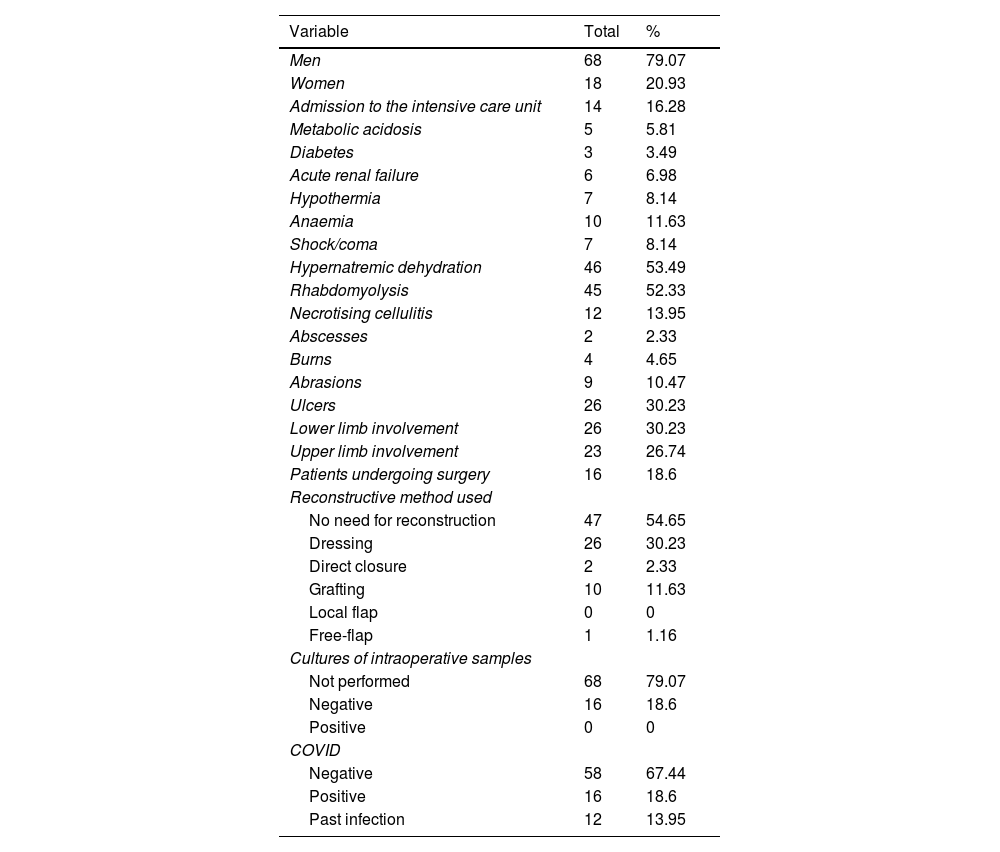In the past few years, the Canary Islands received immigrants from sub-Saharan countries that arrive to the coast after long boat trips in extreme adverse conditions.
The named “trench foot” is a previously described infectious entity developed after feet wounds that get infected by being in contact with water, urine and excrements in these small and crowded boats.
We describe a new clinical entity, not published yet, that consists in massive edema in the extremities associating necrosis of the skin and subcutaneous tissue that characteristically respects the muscle and with a non-infectious etiology.
Material and methodsA Database including 86 patients arrived by boat (“patera”) from sub-Saharan countries from September 2020 to January 2022 was made and 39 qualitative and quantitative items were analyzed. The Research Unit performed an observational prospective statistical analysis.
ResultsA total of 16 patients developed the entity described as necrotizing cellulitis. Its physiopatology completely differs from the one described in the trench foot, since all the cultures resulted sterile.
ConclusionsWe postulate an inflammatory theory due to the osmotic effect from ingesting sea water and/or the aggressive fluid reposition when they arrive to the emergency room with severe dehydration and hypernatremia. Early surgical evacuation of the edema with escharotomies incisions alleviate the symptoms and prevents progression of the disorder.
Las Islas Canarias reciben migrantes de origen subsahariano que llegan a la costa tras largas travesías marinas en condiciones adversas.
El “pie de patera” es una entidad previamente descrita consistente en un cuadro clínico desarrollado a partir de heridas en los pies que se infectan por estar en contacto con aguas fecales estancadas en el fondo de estas embarcaciones.
Describimos un nuevo cuadro clínico, hasta ahora no publicado, consistente en un edema masivo de las extremidades que asocia necrosis de la piel y del tejido celular subcutáneo, respeta el músculo y su etiología no es de origen infeccioso.
Material y métodosDiseñamos un estudio descriptivo observacional entre los meses septiembre del año 2020 y enero del año 2022, ambos incluidos, en el ámbito del Hospital de tercer nivel situado en Gran Canaria. Se incluyeron un total de 86 pacientes en una base de datos donde se analizaron 39 variables cualitativas y cuantitativas.
ResultadosUn total de 16 pacientes desarrollaron el cuadro consistente en una celulitis necrosante estéril. Su fisiopatogenia difiere a la del pie de patera ya que en todos los casos los cultivos resultan estériles.
ConclusionesComo mecanismo responsable, postulamos una teoría inflamatoria derivada del efecto osmótico de la ingesta de agua de mar y/o la reposición agresiva de fluidos a su llegada a los centros hospitalarios donde ingresan con deshidrataciones hipernatrémicas graves. El tratamiento quirúrgico precoz consiste en evacuar el edema mediante incisiones tipo escarotomías, el cual alivia la sintomatología y previene la progresión del cuadro.
Artículo
Comprando el artículo el PDF del mismo podrá ser descargado
Precio 19,34 €
Comprar ahora









